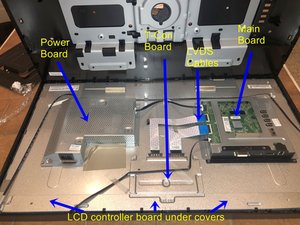This is a general Wiki to describe the most commonly found boards inside a LCD TV. The boards are common to most TV’s but there are manufacturers and models that may either have a variation of the boards or added additional boards for further function. Those would have to be assessed and evaluated by utilizing the service manual for the specific model.
How a LCD TV works
When the TV is connected to an AC supply and turned on, the TV power supply board will received the AC voltage input. From this the power supply board will generate the Standby Voltage 5V (5VSTB) and send it to the Main board. At this stage there will be no further voltages except the 5VSTB.
When the Main Board receives the 5V standby voltage from teh power supply board, it will be routed through a voltage regulator IC or DC-DC circuit to generate a 3.3V voltage. The 3.3V will be supplied to the MCU (microcontroller unit) IC, CPU and the Front Panel board. Now we can see the standby LED light is lit and the TV is in the Standby Mode now.
After pressing the power on switch button, the Main board will send out the Power On signal (PS_ON, PWR_ON or etc marking code) to power supply board. This PS_ON signal will send to Power Supply board PFC section and then the PWM section to generate other voltage outputs like 24V, 12V, 5V, 3.3V etc.to Main board, T-con board and (if present) to the Inverter board/section. Finally the TV can show the display now.
For this Wiki a Samsung LS32D85K was used for demonstration purposes. More on the repair of this model can be found on here Samsung LS32D85KTSR Power Supply Replacement
Once the back panel is removed from the TV now, each type of flat panel TV will have a distinct set of parts. LCD TV’s typically contain these circuit boards:
- Main Board
- Power Supply Board
- T-Con Board
- LCD Panel Controller Boards
- IR Sensor
- Keypad Controller
Optional boards depend on the make and model of are:
- Backlight Inverter Board
- FRC Board
First view once the back cover is removed.

What is a power supply board?
Define what a power supply is and you will most likely get a response such as ‘that box plugged into the mains that powers my equipment’. That’s the function but what it’s doing is very complex. It’s taking raw AC from the mains, normally compatible with any supply voltage in the world (with its tolerances, dips and spikes) and converting it to a stable lower DC voltage. It will incorporate a feedback loop to keep the output voltage constant with changes in input voltage and output load current.
Fast load steps will be reacted to within a designed control loop response time with minimal consequential output voltage transients. It will provide safety isolation to the highest statutory level for the highest standard mains voltage and will remain safe to a minimum level, even with a single component failure. It will have controlled radiated and conducted noise emissions to statutory levels and be immune to noise from other sources.
A good design will have various levels of protection against single internal faults that might potentially cause output over- voltage, chains of multiple component failures, excessive temperatures, electric shock or even fire.
What is the main board?
The Main board also sometimes called the motherboard (comparison is made with a computer motherboard) is the circuit board with the audio and video inputs and outputs connected to it. This is the brains of a TV and can generally be divided into four main functions:
1. Through the CPU and MCU (microcontroller unit) processors it controls the system via multiple signals. For example it is the main board that tells the power board to turn on the backlight; it tells the panel when to turn on/off etc.
2. Process different types of video signal inputs as is evident by the multitude of video connectors i.e. HDMI, COAX, Component etc. It is the Main board that converts these video signals into an RSDS type video signals which is then send to the T-con board via the flat ribbon LVDS cables.
3. The Main board also includes the audio IC (including the audio amplifier where the speakers then connect to
4. The Main board contains a large DC-DC section. It is here where after receiving the power from the power supply board the appropriate voltage for the rest of the system will be determined. Tuner voltages, CPU and GPU as well as the RAM voltage etc., get controlled from here. If the TV should poses 3D or Wi-Fi capacity the Main board will also be in control of those peripheries.



27 Yorum
اصلاح شاشة سمسونغ
fassihabdelghani - Yanıt
i dont know if my main board is out are the black lights are out. i have a full picture under the black screen i use the flash light test and i have sound.
james pettit - Yanıt
Then your problem is with your backlights. As with Christmas tree lights, they are connected in series, so when one goes out they all go out...
Paul Keates - Yanıt
My sony TV turns off after 10 seconds and then the standby light blinks 6 times. I grounded the back light error wire and my TV was working again temporarily for 2 days. My screen was black again but with a flash I could see a moving picture and sound was working. What could be the problem?
Carlos Mendez - Yanıt
Hisense 58A7100f combo board strike by lightning while it was off but plugged to the mains Socket, no standby light. I'm getting 187v AC in but no voltages on the main board, what else can I check
lloyd Rwativenga - Yanıt